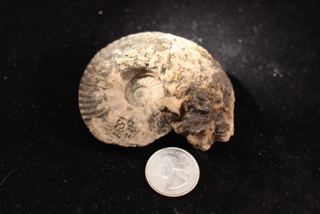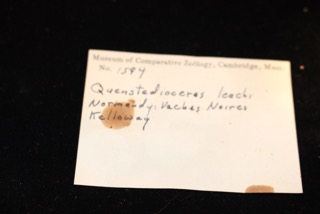
It’s Quenstedtoceras leachi, if the label from Harvard University’s Museum of Comparative Zoology is to be trusted. (After last week’s debacle, in which it was revealed that I can’t tell spirifers apart from fusilinids, I am understandably wary.)

The Q. genus—you will forgive me for not wanting to type its name again—is named for the German paleontologist Friedrich August von Quenstedt (1809–1889), for whom no fewer than five genera were named: Quenstedtia (both a mollusk genus and a coelenterate genus, confusingly), Quenstedtiphyllia (a coelenterate genus), and Quenstedticrinus (a crinoid genus) in addition to Quenstedtoceras. Plus the stem turtle Proganochelys takes its species name quenstedti from von Quenstedt. And as if that weren’t enough, he also scored a mineral, quenstedtite, a form of iron sulfate. I presume that he used to make fun of botanists, since no flora seem to have been named in his honor.
Stephanie Keep adds:
The various Quenstedtoceras species were ammonites—distant cousins to octopuses, squids, and cuttlefish—common in the seas of the middle Jurassic. Ammonites in general are VIPs—Very Important Paleontologicalia—of the middle-late Paleozoic and the entire Mesozoic. Why? They fossilized well, and they’re extremely diverse and widespread. Taken together, these features make ammonites wonderful index fossils.
They are classified into three groups based on their suture patterns (those are the whirly things visible in the photo, not to be confused with the raised ribs). The earliest ammonites (Devonian–Permian) had the simplest sutures, called goniatitic. Ammonites that lived from the late Permian to the Triassic had somewhat complex sutures, described as ceratitic. The latest ammonites, living in the Jurassic and Cretaceous, had the most complex sutures, called ammonitic. This little guy here was an ammonitic ammonoid. Studies suggest that shells with simpler sutures enabled the animals to withstand great pressure, but were not all that great in maintaining buoyancy. Shells with ammonitic sutures, on the other hand, enabled the animals to maintain finely tuned buoyancy, but weren’t too great under pressure.
Congratulations to—well, to me, for stumping you all!—and a tip of the tightly coiled hat to Stephanie Keep for the photograph as well as the ammonite primer.

